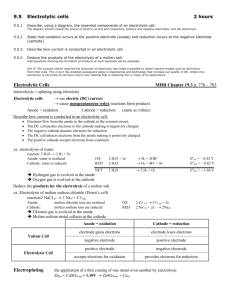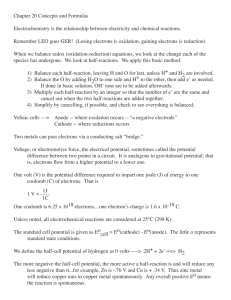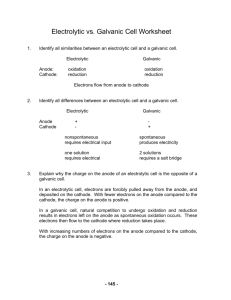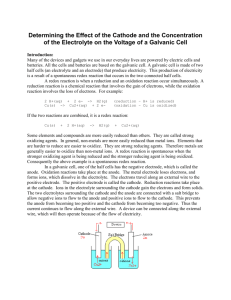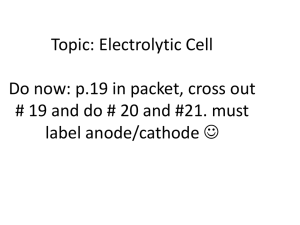Electrolytic Cells - BHS Chemistry
advertisement
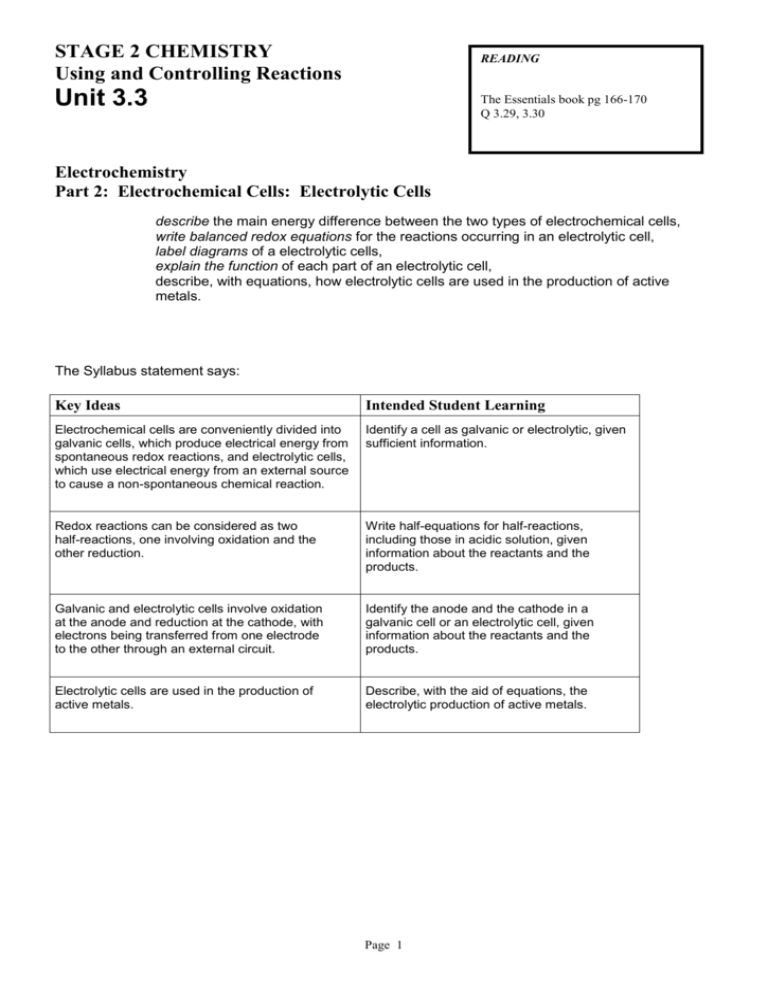
STAGE 2 CHEMISTRY Using and Controlling Reactions READING Unit 3.3 The Essentials book pg 166-170 Q 3.29, 3.30 Electrochemistry Part 2: Electrochemical Cells: Electrolytic Cells describe the main energy difference between the two types of electrochemical cells, write balanced redox equations for the reactions occurring in an electrolytic cell, label diagrams of a electrolytic cells, explain the function of each part of an electrolytic cell, describe, with equations, how electrolytic cells are used in the production of active metals. The Syllabus statement says: Key Ideas Intended Student Learning Electrochemical cells are conveniently divided into galvanic cells, which produce electrical energy from spontaneous redox reactions, and electrolytic cells, which use electrical energy from an external source to cause a non-spontaneous chemical reaction. Identify a cell as galvanic or electrolytic, given sufficient information. Redox reactions can be considered as two half-reactions, one involving oxidation and the other reduction. Write half-equations for half-reactions, including those in acidic solution, given information about the reactants and the products. Galvanic and electrolytic cells involve oxidation at the anode and reduction at the cathode, with electrons being transferred from one electrode to the other through an external circuit. Identify the anode and the cathode in a galvanic cell or an electrolytic cell, given information about the reactants and the products. Electrolytic cells are used in the production of active metals. Describe, with the aid of equations, the electrolytic production of active metals. Page 1 Electrochemical Cells: A Review The KEY IDEAS are: Electrochemical cells are divided into galvanic cells that produce electricity from spontaneous chemical reactions and electrolytic cells that use electricity from an external source to cause a non-spontaneous chemical reaction. In a galvanic cell: In an electrolytic cell: Electricity is produced from a spontaneous redox reaction. Oxidation and reduction take place in separate compartments that are linked by an external circuit or wire. The current flow is due to the movement of electrons through the circuit from the oxidation (loss of electrons) compartment to the reduction (gain of electrons) compartment. Electrical energy is used to force a chemical reaction to take place. The process is called electrolysis. The electrical energy source pushes electrons around a circuit to one part of the cell where reduction (gain of electrons) occurs, and electrons are pulled from another part of the cell where oxidation (loss of electrons) occurs. The chemical reactions in these cases are usually redox reactions involving two half-equations, one for oxidation and the other reduction. You need to be able to balance redox half equations and then write overall redox equations. Both types of cells involve oxidation at the anode and reduction at the cathode, with electrons being transferred from the anode to the cathode through an external wire. Comparing galvanic cells and electrolytic cells You will need to be able to compare the characteristic features of both types of cells and when given information about an electrochemical cell, you will need to be able to: identify it as a galvanic or an electrolytic cell write half-equations for the redox reactions that occur and identify all processes, eg movement of electrons, stating where they occur in the cell. ELECTROCHEMICAL CELLS The following metal Activity Series will be useful when working with electrochemical cells. most reactive least reactive Page 2 ELECTROLYTIC CELLS In an electrolytic cell, electrical energy is converted into chemical energy. The process is called electrolysis and results in a chemical reaction caused by the passage of a current through an electrolyte. The chemical reaction that occurs when electricity passes through a molten ionic compound or through an electrolyte solution is called electrolysis. Solutes that form solutions that can conduct electricity are called electrolytes. An electrolyte solution conducts electricity. Positive ions gain electrons at the cathode and negative ions lose electrons at the anode. This transfer of electrons has the same effect as a flow of electrons, and the solution conducts electricity. The apparatus in which electrolysis occurs is called an electrolytic cell. An electrolytic cell has three essential features: 1. an electrolyte solution that contains free-moving ions. These ions can donate or accept electrons, allowing electrons to flow through the external circuit. 2. two electrodes at which the electrolysis reactions occur 3. an external source of electrons, such as a battery or power pack. This electron flow is in one direction only and is termed DC (direct current). The electrode to which electrons flow from the external power source is the negative electrode and is called the cathode, since reduction will occur there. The electrode from which electrons are withdrawn by the power source is the positive electrode and is called the anode, since oxidation will occur there. Cations are attracted to the cathode, while anions are attracted to the anode. The cations gain electrons from the cathode and the anions lose electrons to the anode. The redox reactions in an electrolytic cell can involve the electrode, or ions in the electrolyte or water molecules if the electrolyte is an aqueous solution. Page 3 ELECTROLYTIC CELLS – SOME EXAMPLES 1 Electrolysis of molten ionic compounds Solid sodium chloride does not conduct electricity. However, when an electric current is passed through molten sodium chloride, a chemical reaction may be clearly observed. A shiny bead of sodium is produced at the cathode and chlorine gas is evolved at the anode. In solid sodium chloride, the oppositely charged sodium ions, Na +, and chloride ions, Cl-, are held tightly together. Heating the solid causes the ions in the crystal to separate so they are then free to move. In an electrolytic cell, the sodium ions are attracted to the cathode where they are reduced: Na+(l) + e- Na(l) The chloride ions are attracted to the anode where they undergo oxidation: 2Cl-(l) Cl2(g) + 2e- Since, in a redox reaction, the same number of electrons are consumed as are produced, the overall equation is: __________________________________________________________________________________________ QUESTION Magnesium may be obtained commercially from seawater. During the last stage of the process, molten magnesium chloride undergoes electrolysis in a cell that contains an iron cathode and a graphite anode. 1 Draw a fully labelled diagram of an electrolytic cell that could be used to produce magnesium. Include equations at each electrode and the overall cell reaction. 2 Predict the product formed at the anode, if iron was used to form the anode instead of graphite in this cell. _____________________________________________________________________________ 3 Why would a molten rather than aqueous solution of magnesium chloride be used? Page 4 2 Electrolysis of water When a current is applied via two electrodes in pure distilled water, no visible reaction occurs. There is no current flow and no electrolysis. If, however, an electrolyte such as H 2SO4 or KNO3 is added in low concentration, the resulting solution conducts electricity and electrolysis will occur. The products of the electrolysis of water, in this case, are hydrogen and oxygen. At the cathode, water is reduced to form hydrogen: H2O(l) + 2e- H2(g) 2OH-(aq) + At the anode, water is oxidised to form oxygen: H2O(l) O2(g) + 4e- + 4H+(aq) The region around the cathode becomes basic owing to an increase in OH -ions, whereas the region around the anode becomes acidic, owing to an increase in H+ ions. The overall cell reaction may be obtained by adding the half-equations: _________________________________________________________________________________________ Page 5 3 Electrolysis of aqueous solutions of ionic compounds When a molten salt is electrolysed, the products are predictable. However, when an aqueous solution of an ionic compound is electrolysed, water may react at one or both of the electrodes in preference to the ions from the salt. Hydrogen sometimes appears at the cathode, rather than a metal, and oxygen sometimes appears at the anode rather than a metal cation or a halogen. Hence, a range of redox reactions can occur with aqueous solutions, depending on the ions present and and the nature of the electrodes. NOTE: The following information is given to help you understand the electrolysis of aqueous solutions but is not required learning. Reduction reactions at the cathode If there are zinc ions or ions of metals less reactive than zinc in the aqueous solution, they will be reduced to the metal. For example, this will happen if an aqueous solution of copper (II) sulfate is electrolysed. Copper ions will be reduced to copper metal and the half-equation is: Cu2+(aq) 2e- + Cu(s) If the solution is acidified, hydrogen ions, H+(aq), will be reduced to hydrogen gas and the half-equation is: 2H+(aq) + 2e- H2(g) If there are no ions of less active metals or there are no hydrogen ions, water molecules will be reduced to hydrogen gas and the half-equation is: H2O(l) + 2e- H2(g) 2OH-(aq) + Oxidation reactions at the anode If the electrode is not an inert metal (platinum, carbon, stainless steel), but a metal (eg copper), then the electrode will be oxidised and go into solution as metal ions. For example: Cu(s) Cu2+(aq) + 2e- If the electrode is inert, and the solution is dilute, water molecules will be oxidised to oxygen gas. H2O(l) O2(g) + 4e- + 4H+(aq) When the electrolyte contains halide ions (Group 7 ions like Cl-), and is reasonably concentrated, the halide ions get oxidised to the halogen. For example: 2Cl-(aq) Cl2(g) + 2e- Page 6 COMPARING GALVANIC AND ELECTROLYTIC CELLS The following represents the main differences between an electrolytic cell and a galvanic cell: In an electrolytic cell, electrical energy is transformed into chemical energy. The electricity supplied causes non-spontaneous chemical reactions to occur at the electrodes. In a galvanic cell, chemical energy is transformed into electrical energy. The spontaneous chemical reactions that occur generate a flow of electricity. In an electrolytic cell, the electricity supplied forces electrons around a circuit. Reduction occurs at the electrode where electrons are gained and oxidation occurs at the electrode where electrons are lost. In a galvanic cell, there is a spontaneous flow of electrons around the circuit. Oxidation occurs at the electrode where electrons are lost. The electrons move around the circuit to the other electrode where they are gained and reduction occurs. In both cells the flow of electrons is balanced by a movement of ions in either the electrolyte or the salt bridge. In a galvanic cell, the anode is negative and the cathode positive. In an electrolytic cell, the anode is positive and the cathode negative. These differences can be summarized in the table below: Page 7 SUPPORTING QUESTIONS – Galvanic/Electrolytic Cells 1 A galvanic cell was assembled where the overall cell reaction was: Mg(s) + Mg2+(aq) Br2(l) + 2Br-(aq) a State the energy transformation in this type of cell. _________________________________________ b Magnesium metal is used as the anode in this cell. Write the half-equation for the reaction at the anode. c Suggest a suitable material to use for the cathode electrode. _________________________________ d In the space below, sketch a diagram of this cell. Identify on your diagram above: i the charge on the electrodes, ii the anode and cathode, iii the direction of electron flow, iv in which the direction the positive ions in the salt bridge would move. 2 An electrolytic cell is assembled where the overall cell reaction is: MgBr2(l) Mg(s) + Br2(l) In the space opposite, sketch a diagram of the cell where this reaction could occur. On your diagram: i Name and give the formula for the electrolyte. ii Name the material of which each electrode is made. iii Show the direction of electron flow. iv Show the movement of ions in the electrolyte. v Label each electrode as cathode or anode. vi Assign a charge to each electrode. vii Write half-equations for oxidation and reduction near each electrode. Page 8 Practical: ELECTROLYTIC CELLS PURPOSE: to assemble a variety of electrolytic cells, to determine the products formed at each electrode, to examine the changing products due to different, to predict the likely products of an electrolysis. METHOD 1 2 3 4 Construct each cell according to the instructions given in the table using a 6V power supply. Draw a labelled diagram of each cell in the space provided. State any observations made. Identification tests: phenolphthalein turns purple in the presence of OH- ions, a base, Chlorine gas bleaches damp red litmus paper. Write half-equations for reactions occurring at each electrode. Cell 1: inert Norwood electrodes, tap water as the Cell 2: copper electrodes, dilute sulfuric acid as the electrolyte. In the cathode, add 2-3 drops of phenolphthalein. electrolyte. Cell 3: inert Norwood electrodes, dilute sodium Cell 4: inert Norwood electrodes, concentrated chloride (0.2 g in 50 mL) as the electrolyte. In the cathode, add 2-3 drops of phenolphthalein. sodium chloride (15g in 50 mL) as the electrolyte. In the cathode, add 2-3 drops of phenolphthalein. Page 9 EXTRA NOTES: _________________________________________________________________________________ _________________________________________________________________________________ _________________________________________________________________________________ _________________________________________________________________________________ _________________________________________________________________________________ _________________________________________________________________________________ _________________________________________________________________________________ _________________________________________________________________________________ _________________________________________________________________________________ _________________________________________________________________________________ _________________________________________________________________________________ _________________________________________________________________________________ _________________________________________________________________________________ _________________________________________________________________________________ _________________________________________________________________________________ _________________________________________________________________________________ _________________________________________________________________________________ _________________________________________________________________________________ _________________________________________________________________________________ _________________________________________________________________________________ _________________________________________________________________________________ _________________________________________________________________________________ _________________________________________________________________________________ _________________________________________________________________________________ _________________________________________________________________________________ _________________________________________________________________________________ _________________________________________________________________________________ _________________________________________________________________________________ _________________________________________________________________________________ _________________________________________________________________________________ _________________________________________________________________________________ Page 10

